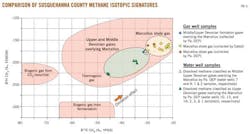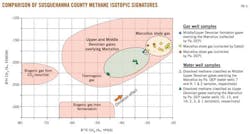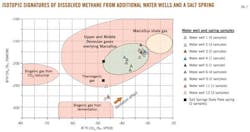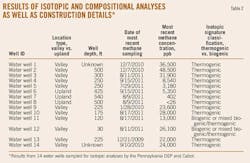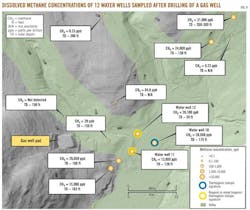P. 6 ~ Continued - Methane in Pennsylvania water wells unrelated to Marcellus shale fracturing
Displaying 6/10
View Article as Single page
Upper and Middle Devonian gases overlying the Marcellus may also be distinguishable based upon isotope analyses; however, in the Pennsylvania DEP study, the open well annulus connected these two zones and did not facilitate separate analyses.
The Pennsylvania DEP also analyzed groundwater samples from five local water wells for the matching suite of dissolved gas parameters, all of which were determined to be consistent with either Upper/Middle Devonian gases or just Upper Devonian gases overlying the Marcellus by the Pennsylvania DEP.
Several of the water wells were sampled multiple times, resulting in 11 total samples as shown on Fig. 6, which plots the isotopic signatures of gases identified as Marcellus, overlying Upper/Middle Devonian, and Upper Devonian. It is important to note that these isotopic signatures are representative of the study area and may vary regionally across the Appalachian basin. Specifically, other studies of thermogenic gas in different parts of Pennsylvania and the Appalachian basin have found the stable isotopic signatures of gases from the Marcellus and shallower Middle and Upper Devonian deposits to be less distinguishable.31
In 2009 and 2010, the Pennsylvania DEP and Cabot analyzed additional dissolved methane samples from nine more water wells in the Dimock area for the isotopic and compositional signatures of gases. Cabot also analyzed two samples of dissolved methane from a natural spring in Salt Springs State Park, which is the location of well known historic gas seeps. Several of the wells and the spring were sampled multiple times, amounting to 23 total samples (Fig. 7).
The results of these analyses show that the methane gas in seven of the nine water wells exhibited an isotopic signature consistent with that of thermogenic gas from the shallow Upper/Middle Devonian and Upper Devonian gas sources, i.e., less thermally mature than Marcellus gas.
Two of the nine wells exhibited an isotopic signature consistent with biogenic gas that may have undergone oxidation or potentially mixed with small amounts of thermogenic gas, two processes that would serve to increase the δ13C and δ2H values. The isotopic signature of methane in the natural spring in Salt Springs State Park also appears thermogenic in origin, though the more negative δ13C and δ2H values may indicate slight mixing with biogenic methane (Fig. 7). Information regarding the results of isotope and compositional analyses, as well as construction details of all 14 water wells sampled for isotope analyses by the Pennsylvania DEP and Cabot is provided in Table 2.
Of the 14 water wells sampled for isotope analyses by the Pennsylvania DEP and Cabot, 11 were located in valleys. Comparison of the methane concentrations in these lowland wells to those located in uplands supports the observation that higher methane concentrations are typically found in lowland water wells (Table 2).
The biogenic nature of gas originating from alluvium and glacial till vs. the thermogenic nature of gas migrating from Upper Devonian sandstone deposits is illustrated by the example in Fig. 8. As shown in the figure, three of the wells sampled for isotope analyses (water wells 10, 11, and 12) are located in the same valley in close proximity to one another and a neighboring gas well drilled in 2008 prior to sampling. (This figure also shows the locations, dissolved methane concentrations, and total depths of nine other proximate water wells sampled after drilling of the local gas well. However, these wells were not sampled for isotope analyses.)
It is important to note that although the dissolved methane concentrations and the locations of the three wells sampled for isotope analyses are relatively similar, the isotopic signatures of the methane are consistent with different sources. Water wells 11 and 12, for which available information indicates total well depths ranging from 30 to 120 ft terminating in shallow alluvium or glacial till, contain biogenic or mixed biogenic/thermogenic methane. In contrast, the remaining water well (water well 10) contains principally thermogenic methane consistent with that of Upper Devonian deposits.
Displaying 6/10
View Article as Single page
